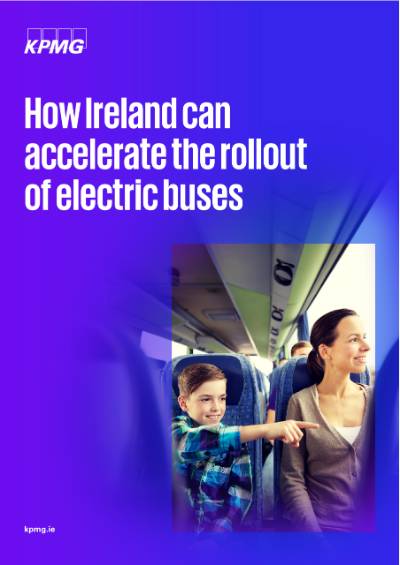Climate change and local air pollution have driven global efforts to decarbonise transport, and electric buses are emerging as a key solution. Our KPMG transport specialists explore the possibilities below.
In Europe, battery electric vehicles (BEVs) have become a cornerstone of transport policy, with city buses leading the charge thanks to their manageable daily mileage. The global push for electric buses is yielding results: In 2024, BEVs accounted for 49% of new city bus sales across the EU—a significant milestone toward the target of 100% zero-emission city buses by 2035.
In addition, the EU saw a 22% growth in e-bus registrations in 2024, and leading nations such as Denmark and the Netherlands have achieved 100% of their new city bus sales being zero-emission.
Towards electrification
In Ireland, the urgency to transition to zero-emission transport is enshrined in its Climate Action Plan, which includes a commitment to achieving a 51% reduction in greenhouse gas emissions by 2030.
The plan emphasises the electrification of public transport fleets as a critical step. Legislation such as Ireland’s Climate Action and Low Carbon Development (Amendment) Act 2021 sets legally binding targets, holding the government accountable for emissions reductions.
Additionally, the Republic of Ireland has pledged to phase out the sale of internal combustion engine (ICE) vehicles by 2030, driving the need for rapid advancements in electric vehicle infrastructure and deployment.
In Northern Ireland, the urgency to transition to zero-emission transport is underscored by the UK’s commitment to end the sale of new petrol and diesel cars by 2030, with certain hybrid vehicles permitted until 2035. Translink, Northern Ireland’s primary public transport provider, has launched a Climate Positive Strategy aiming for net-zero emissions across buses, trains, and facilities by 2040, demonstrating a proactive approach to sustainable transport solutions.
Ireland has made notable progress, deploying 250 electric buses across the Republic of Ireland and 147 across Northern Ireland. However, compared to The Netherlands’ 1,860, Norway’s 1,415 or Sweden’s 1,213, there is room for more ambitious action. For Ireland to fully embrace the transition to electric buses, overcoming infrastructural, financial, and logistical challenges is imperative.
Challenges in transitioning to electric buses
The deployment of electric buses requires substantial investment in charging infrastructure. Ireland must establish adequate charging facilities, primarily charging depots with some charging points along urban bus routes, while ensuring the power grid can meet the increased demand.
By 2030, the network will need to manage a tripling of intermittent renewable generation capacity, up to 600,000 new heat pumps, and up to 1 million electric vehicles in addition to increased demand from new tech loads and data centres.
However, the national electricity network is already facing significant constraints and substantial upgrades to the network are needed in the coming years. Connecting depots to the grid presents additional challenges, including securing suitable locations, optimising layouts for operational efficiency, and complying with regulatory standards.
A further complication is that charging infrastructure is typically fixed in place, whereas bus routes, particularly in an urban setting, can be subject to change. This can create challenges in accessing charging infrastructure or lead to the unintended consequence of route planning being dictated by the availability of charge points.
To date, all of Ireland’s electric buses have been ordered from Wrightbus, a Northern Ireland-based company. The NTA signed an agreement with Wrightbus to supply up to 800 electric buses to the Republic of Ireland over a five-year period, beginning in 2022.
However, with growing demand across Europe, bus manufacturers’ continued growth is highly dependent on the resilience and efficiency of their supply chain to fulfil all orders.
Globally, the supply chain for electric buses is still experiencing post-pandemic disruptions, in particular with respect to access to raw materials required for battery production coming principally from the African continent.
With newer technologies, a move away from the reliance on cobalt and nickel could alleviate pressures across the supply chain, provide greater certainty of supply, and more stable costs. An overreliance on one supplier nationally might put Ireland in a vulnerable position with respect to supply.
While electric buses have lower Total Cost of Ownership (TCO) due to savings on fuel and maintenance, their upfront costs remain a barrier. Recent studies suggest that electric buses are, on average, 50% more expensive than their ICE equivalents, with some price volatility due to the varying availability of cobalt for battery production.
Beyond the cost of vehicles, the initial investment required for charging infrastructure, including high fees for connection to the power grid, adds to the financial burden. These investments compete with other decarbonisation solutions, which may be considered more favourable due to lower upfront investments or the perception of being an “easier win”.
Battery range and charging time are critical factors that influence the practicality of transitioning to electric buses. While manufacturers are making strides in improving these features, with advances in battery technology rapidly coming onstream, transport operators must also contribute by carefully planning fleet schedules to minimise bus (and driver) downtime due to charging requirements, subsequent disruptions to service schedules, and to accommodate for the charging time when buses are not in use.
Addressing these challenges requires a coordinated and strategic approach that balances immediate needs with long-term goals. Overcoming infrastructure gaps, supply chain constraints, and high upfront costs demands collaboration between public authorities, private stakeholders, and international partners.
By building on lessons from successful transitions in other countries, Ireland can develop tailored solutions to accelerate the adoption of electric buses and ensure a sustainable, efficient, and equitable transition. Key actions and recommendations to accelerate the transition are outlined next.
Recommendations for faster adoption
To facilitate the rapid expansion of electric bus fleets, Ireland needs a strategic plan for public transport charging infrastructure. This includes ensuring that depots are upgraded where necessary and equipped to handle large-scale charging demands and integrating bus renewal programs with charging infrastructure plans.
The government must also work with utilities to ensure the power grid can support these upgrades without compromising reliability.
The success of Ireland’s electric bus transition depends on a robust and reliable power supply. Strategic upgrades to the national grid are essential to ensure it can handle the growing demand for high-capacity charging infrastructure and other competing energy uses.
Investments must focus on scaling grid capacity to support charging depots without compromising overall grid stability. Early engagement with system operators through a clear strategy or timely grid connection applications can improve visibility of future demand, increasing the likelihood of infrastructure upgrades being prioritised.
While the NTA has made significant investments, an optimised contracting structure is essential to accelerate the transition to electric buses. Reviewing the current contracting structure—in which the NTA is the primary investor, not individual operators—would require a critical assessment of stakeholder responsibilities and roles.
This includes payment flows related to electric bus supply and overall bus operations, as well as procurement and funding considerations. Exploring alternative contracting structures can play a pivotal role in accelerating electrification.
Ireland can draw inspiration from countries like Norway and the Netherlands, where well-designed financial incentives have successfully driven the transition to electric buses, due to control of fleet supply being typically under the remit of transport operators.
Ireland should actively engage with multiple electric bus manufacturers and suppliers to reduce reliance on a single local supplier. Establishing partnerships with a diverse range of manufacturers can enhance competition, ensure a steady supply of vehicles, and mitigate risks associated with supply chain disruptions.
Additionally, Ireland could explore incentives to attract international manufacturers to establish a local presence, ranging from aftermarket support to full-scale assembly facilities. This approach would not only strengthen the supply chain but also boost domestic expertise in clean transport technologies and create highly skilled jobs.
Ireland should capitalise on its access to EU grants and funding under programs like the European Green Deal and Horizon Europe. These resources can help bridge funding gaps for infrastructure and vehicle purchases.
Get in touch
KPMG combines deep industry expertise with global best practices, offering data-driven insights and tailored strategies. Our cross-disciplinary teams collaborate with governments, financial institutions, and industry leaders to deliver actionable solutions that drive real impact. We leverage our international network to benchmark successful models and adapt them to local contexts.
KPMG can help you navigate the transition to a sustainable transport future. Get in touch with our team to discuss how we can support your electrification strategy and infrastructure investments.
Discover more in Strategy
4 Results
Nothing found



